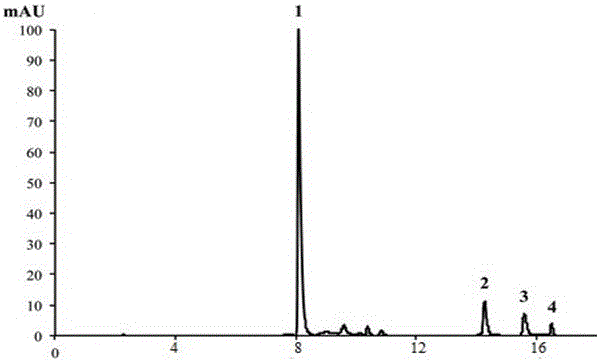Method for preparing polypeptide and astaxanthin from shrimp and crab processing waste
A technology of astaxanthin and waste, applied in the field of preparation of polypeptide and astaxanthin, to achieve the effect of reducing environmental pollution, mild conditions and good safety
- Summary
- Abstract
- Description
- Claims
- Application Information
AI Technical Summary
Problems solved by technology
Method used
Image
Examples
Embodiment 1
[0047] A method for preparing polypeptide and astaxanthin from shrimp and crab processing waste, comprising the steps of:
[0048] 1) Raw material pretreatment:
[0049] Collect 10kg of shrimp shells, remove moldy shrimp shells, wash with tap water to remove sediment and seaweed, drain, crush and beat the slurry, pass the slurry through a 60-mesh sieve, and add a mixed solution of electrogenerated functional water and hydrochloric acid to make the pH of the system 1. After stirring at 150r / min for 6h, centrifuge at 3000r / min with a flat-panel centrifuge equipped with a 600-mesh filter cloth, collect the precipitate a, and store it at low temperature for later use.
[0050] 2) Material enzymatic hydrolysis:
[0051] Add the precipitate a to the electro-generated functional water with a pH of 8.5-9.0 at a material-to-liquid ratio of 1:10 (m / V), then add the complex protease at 3% of the enzyme amount, and stir at 300r / min at 40°C Hydrolysis 4h. After the enzymatic hydrolysis ...
Embodiment 2
[0057] A method for preparing polypeptide and astaxanthin from shrimp and crab processing waste, comprising the steps of:
[0058] 1) Raw material pretreatment:
[0059] Collect 20kg of crab shells, remove the moldy part, wash with tap water to remove sediment and seaweed, drain, crush and beat the slurry, pass the slurry through an 80-mesh sieve, add a mixed solution of electrogenerated functional water and hydrochloric acid, and make the pH of the system 0. After stirring at 200r / min for 6h, centrifuge at 3500r / min with a flat-panel centrifuge equipped with a 600-mesh filter cloth, collect the precipitate a, and store it at low temperature for later use.
[0060] 2) Material enzymatic hydrolysis:
[0061] Add the precipitate a to the electro-generated functional water with a pH of 9.0-10.0 at a material-to-liquid ratio of 1:15 (m / V), then add the complex protease at 5% of the enzyme amount, and stir at 50°C at a speed of 300r / min Hydrolysis 3h. After the enzymatic hydroly...
Embodiment 3
[0067] A method for preparing polypeptide and astaxanthin from shrimp and crab processing waste, comprising the steps of:
[0068] 1) Raw material pretreatment:
[0069] Collect 15 kg of shrimp shells, remove moldy shrimp shells, wash with tap water to remove sediment and seaweed, drain, crush and beat the slurry, pass the slurry through a 100-mesh sieve, and add a mixed solution of electrogenerated functional water and hydrochloric acid to make the pH of the system 2, After stirring at 200r / min for 9h, centrifuge at 3500r / min with a plate centrifuge equipped with an 800-mesh filter cloth, collect the precipitate a, and store it at low temperature for later use.
[0070] 2) Material enzymatic hydrolysis:
[0071] Add the precipitate a to the electro-generated functional water with a pH of 8.5-9.5 at a material-to-liquid ratio of 1:12 (m / V), then add the compound protease at 5% of the enzyme amount, and stir at 50°C at a speed of 300r / min Hydrolysis 6h. After the enzymatic h...
PUM
 Login to View More
Login to View More Abstract
Description
Claims
Application Information
 Login to View More
Login to View More - R&D
- Intellectual Property
- Life Sciences
- Materials
- Tech Scout
- Unparalleled Data Quality
- Higher Quality Content
- 60% Fewer Hallucinations
Browse by: Latest US Patents, China's latest patents, Technical Efficacy Thesaurus, Application Domain, Technology Topic, Popular Technical Reports.
© 2025 PatSnap. All rights reserved.Legal|Privacy policy|Modern Slavery Act Transparency Statement|Sitemap|About US| Contact US: help@patsnap.com

